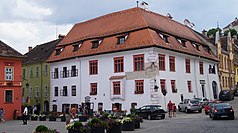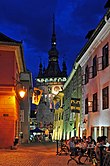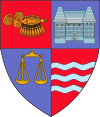Sighișoara
Sighișoara
| |
|---|---|
| |
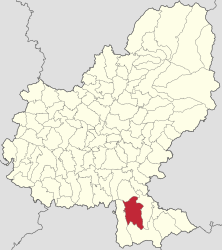 Location in Mureș County | |
| Coordinates: 46°13′1″N 24°47′28″E / 46.21694°N 24.79111°E | |
| Country | Romania |
| County | Mureș |
| Government | |
| • Mayor (2020–2024) | Iulian Sîrbu[1] (UIPS) |
| Population (2021-12-01)[2] | 23,927 |
| Time zone | EET/EEST (UTC+2/+3) |
| Vehicle reg. | MS |
| Website | www |
| Official name | Historic Centre of Sighișoara |
| Type | Cultural |
| Criteria | iii, v |
| Designated | 1999 (23rd session) |
| Reference no. | 902 |
| Region | Europe |
Sighișoara (Romanian: [siɡiˈʃo̯ara]; Hungarian: Segesvár [ˈʃɛɡɛʃvaːr] ; German: Schäßburg [ˈʃɛsbʊʁk]; Transylvanian Saxon: Schäsbrich, Šesburχ, or Scheeßprich;[3] Yiddish: שעסבורג, romanized: Shesburg; Latin: Castrum Sex or Saxoburgum) is a municipality on the Târnava Mare River in Mureș County, central Romania. Located in the historic region of Transylvania, Sighișoara had a population of 23,927 according to the 2021 census. It is a popular tourist destination for its well-preserved old town, which is listed by UNESCO as a World Heritage Site. The town administers seven villages: Angofa, Aurel Vlaicu, Hetiur, Rora, Șoromiclea, Venchi, and Viilor.
History
[edit]This section needs additional citations for verification. (September 2013) |
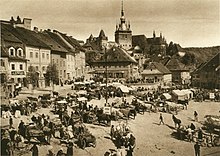
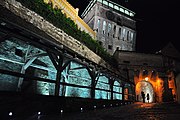
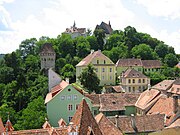
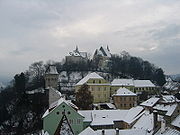
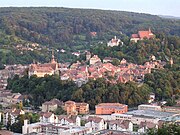
Starting with the mid 12th century, German craftsmen and merchants known as the Transylvanian Saxons (German: Siebenbürger Sachsen) were invited to Transylvania by the then King of Hungary, Géza II, to settle and defend the frontier of his realm and improve the region's economy. The chronicler Krauss lists a Saxon settlement in present-day Sighișoara by 1191.[citation needed] A document of 1280 records a town built on the site of a Roman fort as Castrum Sex or "six-sided camp", referring to the fort's shape of an irregular hexagon.[4] Other names recorded include Schaäsburg (1282), Schespurg (1298) and Segusvar (1300).[5] By 1337 Sighișoara had become a royal center for the kings, who awarded the settlement urban status in 1367 as the Civitas de Segusvar.
The town played an important strategic and commercial role at the edges of Central Europe for several centuries. Sighișoara became one of the most important urban centres of Transylvania, with artisans from throughout the Holy Roman Empire visiting the settlement. The German artisans and craftsmen dominated the urban economy, as well as building the fortifications protecting it. It is estimated that during the 16th and 17th centuries Sighișoara had as many as 15 guilds and 20 handicraft branches. The Baroque sculptor Elias Nicolai lived in the town. The Wallachian voivode Vlad Dracul (father of Vlad the Impaler), who lived in exile in the town, had coins minted in the town (otherwise coinage was the monopoly of the Hungarian kings in the Kingdom of Hungary) and issued the first document listing the city's Romanian name, Sighișoara.[citation needed] The Romanian name is first attested in 1435, and derives from the Hungarian Segesvár, where vár is "fort".[4][5]

The town was the setting for George I Rákóczi's election as Prince of Transylvania and King of Hungary in 1631. Sighișoara suffered military occupation, fires, and plagues during the 17th and 18th centuries. An important source for the history of 17th-century Transylvania, for the period of 1606–1666, are the records of Georg Kraus, the town's notary.[6]
The nearby plain of Albești was the site of the Battle of Segesvár, where the revolutionary Hungarian army led by Józef Bem was defeated by the Russian army led by Lüders on 31 July 1849. A monument was constructed in 1852 to the Russian general Skariatin, who died in the battle. The Hungarian poet Sándor Petőfi is generally believed to have been killed in the battle, and a monument was constructed in his honor at Albești in 1897. After World War I Sighișoara passed with Transylvania from Austria-Hungary to the Kingdom of Romania.
Central Sighișoara has preserved in an exemplary way the features of a small medieval fortified town. It has been listed by UNESCO as a World Heritage Site. Each year, a medieval Festival takes place in the old citadel in July.
In Eastern Europe and Southeastern Europe, Sighișoara is one of the few fortified towns that are still inhabited. The town is made up of two parts. The medieval stronghold was built on top of a hill and is known as the Citadel (Cetatea). The lower town lies in the valley of Târnava Mare river.
The houses inside Sighișoara Citadel show the main features of a craftsmen's town. However, there are some houses that belonged to the former patriciate, like the Venetian House and the House with Antlers.
Between 2001 and 2003, the construction of a Dracula theme park in the Braite nature preserve near Sighișoara was considered but ultimately rejected, owing to the strong opposition of local civil society groups and national and international media as well as politically influential persons, as the theme park would have detracted from the medieval style of the city and would have destroyed the nature preserve.
Demographics and name
[edit]| Year | Pop. | ±% |
|---|---|---|
| 1910 | 10,913 | — |
| 1930 | 13,033 | +19.4% |
| 1948 | 18,284 | +40.3% |
| 1956 | 20,363 | +11.4% |
| 1966 | 25,109 | +23.3% |
| 1977 | 33,208 | +32.3% |
| 1992 | 36,170 | +8.9% |
| 2002 | 32,287 | −10.7% |
| 2011 | 28,102 | −13.0% |
| 2021 | 23,927 | −14.9% |
| Source: Official Romanian census data | ||
Ethnic groups in 2011:[7]
- Romanians (75%)
- Hungarians (17.6%)
- Roma (5.3%)
- Germans (more specifically Transylvanian Saxons) (1.5%)
| In Romanian | In German | In Hungarian |
|---|---|---|
| Sighișoara | Schäßburg | Segesvár |
| Angofa | Ungefug | Angofa |
| Aurel Vlaicu | — | Haufan |
| Hetiur | Marienburg bei Schäßburg |
Hétúr |
| Rora | Rohrau | Róra |
| Șoromiclea | — | — |
| Venchi | Wench | Venk |
| Viilor | Kulturberg | Szőlőskert |
Sights
[edit]Sighișoara is a popular tourist destination for its well-preserved walled old town, which is also listed by UNESCO as a World Heritage Site. The main Citadel's attractions are certainly the towers. The city is also an attraction on the Via Transilvanica long-distance trail.[8]
Towers
[edit]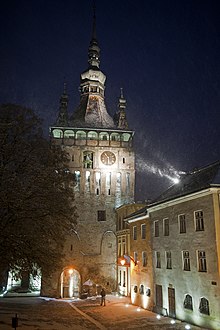
According to ancient military architectures writings, the defence towers had to be a fortification system for the mutual defense, and, at the same time, each tower was supposed to be an independent fortress: a break at the base of a tower did not mean entering into the city, capturing a tower did not have to lead to the conquest of the city. Most of these towers were hollow and equipped with elevators and underground galleries.
- Sighișoara Clock Tower (Turnul cu Ceas) – the landmark of the city is a 64 m-high tower built in the 13th century. Today it is a museum of history.
- The Tinsmiths' Tower (Turnul Cositorarilor)
- The Butchers' Tower (Turnul Măcelarilor)
- The Bootmakers' Tower
- The Tailors' Tower (Turnul Croitorilor)
- The Furriers' Tower (Turnul Cojocarilor)
- The Ironsmiths' Tower (Turnul Fierarilor)
- The Ropemakers' Tower (Turnul Frânghierilor)
- The Tanners' Tower (Turnul Tăbăcarilor)
- The Face Tower – tower on the route to Târgu Mureș, out of the citadel, but still worth visiting thanks to its story.
Churches
[edit]
- The church on the hill (Biserica din Deal) – is undoubtedly one of the most valuable architectural monuments of the city and has been one of the most representative buildings of the gothic site of Romania.
- The Monastery Church (Biserica Mânăstirii Dominicane) – is a gothic style architectural monument which is placed in the neighbourhood of the Clock tower and it was built at the beginning of the 13th century. It is the only church without a bell: the reason is basically that the Saxons weren't great spenders and thought that one bell, the one of the Church on the hill, was enough for the whole city.
- The Saint Joseph Roman Catholic church
- Leprosy Church (Biserica Leproșilor)
- The Orthodox Cathedral of Sighișoara (Catedrala Ortodoxă)
- The old Orthodox church
Civil architecture
[edit]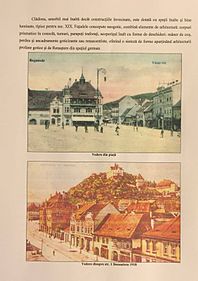
Most of the 164 houses in the town having at least 300 years are considered historical monuments, as follows: those in the Town Square (or Citadel Square), with its rectangular plan, was once inhabited by noble families of the town, though it has undergone too many transformations over time. The best houses are the ones that have kept their original shape.
- House on the Rock (Casa de pe stâncă)
- House with shingles (Evert) – is dedicated to craftsmen for Educational Interethnic Centre for Youth.
- Venetian House or Green House (Casa Venețiană)
- Vlad Dracul's House
- Sighișoara City Hall
- Sighișoara hotel complex – built between 1886 and 1889 was the seat of city hall.
- Indoor wooden staircase or the Scholar's Stairs
- School on the Hill
- The Stag House (Casa cu Cerb)
- The Citadel Square (Piața Cetăți)
- Casa Asociatiei Mestesugaresti (La Perla)
- Joseph B. Teusch Building (Hotel Central Park)
Natives
[edit]
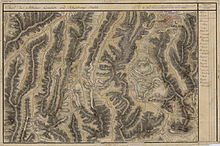
- Johann Michael Ackner, Transylvanian Saxon archaeologist
- Doina Cojocaru, handball player
- Friedrich Grünanger, architect
- Ralph Gunesch, former professional German football player
- Adrian Ivanițchi, folk guitarist
- Johannes Kelpius, a German intellectual, musician, and mystic who founded a religious community when he immigrated to the American colony of Pennsylvania in the late seventeenth century
- Gabriel Mureșan, footballer
- Marie Stritt, German feminist and suffragist
- Georg Daniel Teutsch, Lutheran bishop
- Vlad III the Impaler, prince of Wallachia, inspiration for fictional vampire Count Dracula
- Radu Voina, former handball player, currently coach
International relations
[edit]Twin towns – sister cities
[edit]Sighișoara is twinned with:
Gallery
[edit]-
Downtown Sighișoara
-
Sighișoara medieval festival
-
Downtown Sighișoara by night in winter
-
Downtown Sighișoara by day
-
The Stag House (Romanian: Casa cu Cerb) in Sighișoara
-
The citadel square by night
-
Sighișoara town hall
-
Tailors' Tower by night
-
Joseph Haltrich high school
-
Central Sighișoara in the winter
-
19th century reenacted drawing of Sighișoara
See also
[edit]Notes
[edit]- ^ "Results of the 2020 local elections". Central Electoral Bureau. Archived from the original on 9 October 2020. Retrieved 11 June 2021.
- ^ "Populaţia rezidentă după grupa de vârstă, pe județe și municipii, orașe, comune, la 1 decembrie 2021" (XLS). National Institute of Statistics.
- ^ Verband der Siebenbürger Sachsen in Deutschland e.V. (i.e. Association of Transylvanian Saxons in Germany). "Schäßburg". Siebenbuerger.de (in German). Archived from the original on 6 March 2023. Retrieved 6 March 2023.
- ^ a b Adrian Room, Placenames of the World, p.347. McFarland, 2006, ISBN 0-7864-2248-3.
- ^ a b Cristian Tălângă (ed.), Transilvania, Maramureș, Bucovina, p.27. Editura Semne, Bucharest, 2007.
- ^ Erdélyi krónika 1608-1666 Archived 26 October 2022 at the Wayback Machine (in Hungarian)
- ^ "2011 census data" (PDF). Archived from the original (PDF) on 26 November 2013. Retrieved 24 March 2012.
- ^ "Terra Saxonum | Via Transilvanica". www.viatransilvanica.com (in Romanian). Archived from the original on 14 August 2023. Retrieved 14 August 2023.
- ^ "Miasta partnerskie – Zamość". Urząd Miasta Zamość (in Polish). Archived from the original on 28 January 2017. Retrieved 26 July 2013.
External links
[edit]- 360° Panoramic Images of Sighișoara - Part 1 and Part 2
- The City of Sighișoara – official website
- TOP 10 Guides: Best of Sighișoara
- Lets Go To Romania
- Sighișoara 360 Virtual Tour & Medieval Festival photo gallery
- Sighișoara Pictures
- Sighișoara, Romania: The Purported Home Of Dracula – slideshow by The Huffington Post
- Images from Sighișoara by Canadian Photographer Carey Nash
- (2012) HDR Photos of Sighișoara by Moldavian Photographer Dumitru Brinzan
- Tourist informations, photo gallery and webcam from Sighisoara

